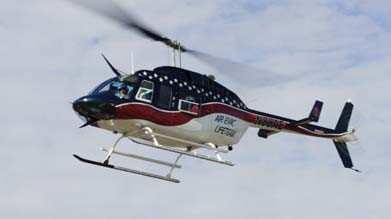Fri, Nov 03, 2017
Improper Maintenance Could Lead To Loss Of Tail Rotor Drive
The FAA has issued a Special Airworthiness Information Bulletin reminding owners, operators, and maintainers of the importance of properly maintaining the tail rotor drive shaft flexible couplings on Bell Helicopter Textron Canada Limited Model 206, 206A, 206B, 206B-1, 206L, 206L-1, 206L-3, and 206L-4 helicopters and other models with similar design features. Failure to properly maintain the coupling may result in loss of coupling fastening hardware and subsequent loss of tail rotor drive.

Transport Canada Civil Aviation (TCCA), which is the authority for the state of design of Bell Helicopter Textron Canada Limited rotorcraft, including the Model 206 series, has issued Civil Aviation Safety Alert No. 2017-02 (CASA).
There have been a number of Bell Helicopter Model 206 series accidents involving tail rotor drive system failures. In several of these occurrences it was noted during the investigation that the hardware (bolt, washer and/or nut) that is used to assemble the flexible couplings in the tail rotor drive shafting was missing. The flexible coupling is also known as a Thomas coupling.
The maintenance manual specifies the installation torque to apply to the nut. In addition, there are maintenance steps to verify the tare torque of the nut. Tare torque, also known as run-on torque, is the rotational force required to turn the nut on the bolt, overcoming the friction of the self-locking feature.
Between 10 and 25 operating hours after installation of this hardware, there is a maintenance manual requirement to perform a torque check on the hardware. If, after application of the minimum torque, there is no movement of the fastener, the installation is considered acceptable. There is also a requirement in the maintenance manual to perform the torque check every 100 hours.
Recommendations:
- Review the respective manufacturer’s standard practice for replacement of self-locking nuts. Most manufacturers call out tare torque requirements. Use a calibrated torque wrench when installing this hardware. In addition, replacing the nut rather than reusing it is recommended.
-
Review the respective manufacturers maintenance manual to ensure the work is completed as specified in the Instructions for Continued Airworthiness (ICA). In addition to installation and tare torque requirements at installation:
- Perform torque check per the Special Inspections section of the applicable maintenance manuals.
- Perform all scheduled torque checks per the applicable maintenance manuals.
- Mark installed hardware with torque seal/lacquer after it has passed torque check. The marking allows visual detection of hardware that may have loosened before it falls off.
- Although it may not be required by your standard operating procedures (SOPs) nor by regulatory requirements, it is a recognized good practice to have a qualified person go back and review the safety and security of critical systems that have had maintenance performed on them. This is similar to a required inspection item (RII) that many commercial operators are required to practice.
- Avoid distractions and interruptions while performing maintenance actions. Review your organization’s policies and procedures on use of cell phones or other electronic media while performing maintenance on aircraft.
(Image from file)
More News
Aviation Governance Secured...At Least For a While The National Business Aviation Association similarly applauded the passage of the FAA's recent reauthorization, contentedly recou>[...]
Emphasis On Growing The Future of Aviation Through Concentration on 'AFFORDABLE FLYERS' It's been a number of years since the Latest Edition of Jim Campbell's HUGE SportPlane Resou>[...]
Amazilia Aerospace GmbH, Develops Digital Flight Control, Flight Guidance And Vehicle Management Systems Textron eAviation has acquired substantially all the assets of Amazilia Aer>[...]
Honeywell's Primus Brings New Tools and Niceties for Hawker Operators Hawker 4000 business jet operators have a new installation on the table, now that the FAA has granted an STC f>[...]
Company Celebrates Niche-but-Important Advancement in Industry Standards Echodyne has announced full integration of its proprietary 'EchoFlight' radar into the e American Aerospace>[...]
 Bolen Gives Congress a Rare Thumbs-Up
Bolen Gives Congress a Rare Thumbs-Up The SportPlane Resource Guide RETURNS!!!!
The SportPlane Resource Guide RETURNS!!!! Buying Sprees Continue: Textron eAviation Takes On Amazilia Aerospace
Buying Sprees Continue: Textron eAviation Takes On Amazilia Aerospace Hawker 4000 Bizjets Gain Nav System, Data Link STC
Hawker 4000 Bizjets Gain Nav System, Data Link STC Echodyne Gets BVLOS Waiver for AiRanger Aircraft
Echodyne Gets BVLOS Waiver for AiRanger Aircraft



